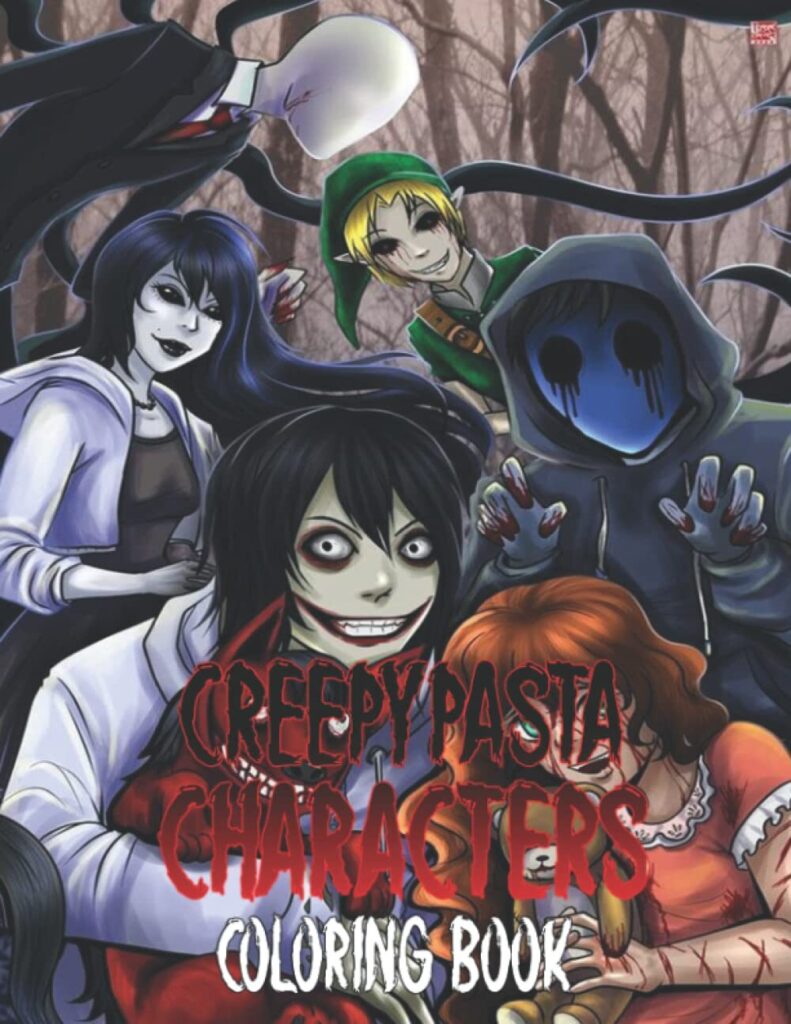If I Call Creepypastas “Outsider Art” Will I Sound Deep?

Eagle-eyed readers may have noticed that I’ve been doing something a little different with my last few posts on the blog. I’ve been focusing more on small essays. It’s a little goal of mine to try to find an interesting…dare I say, intellectual…angle on the things we’ve been reading. The killers, Jeff and Jane, presented a bit of a challenge in that regard. They are silly stories made up by (likely) children who had no idea what they were doing. As far as the “craft” of writing goes, these are objectively bad stories. Despite this, there is something compelling about them. These characters and these stories have real staying power. Thousands of people, myself included, love and enjoy these things, perhaps ironically and perhaps not. Pondering this conundrum, I had a sudden thought: If I call creepypastas “outsider art”, will I sound deep? Let’s hope.
The term “Outsider Art” refers to art that is made by individuals who lack formal training, and especially those individuals who exist outside of the accepted culture of the art world. “Outsider Art” is an English translation of what French artist, Jean Dubuffet, described as “Art Brut.” Another way to translate that would be “Raw Art.” Dubuffet was particularly interested in art created by people in psychiatric institutions. Other artists interested in outsider art have focused on “peasant art”, “folk art”, “children’s art”, etc.
In contrast with artists who have traditional education and training, the outsider artist is supposedly uninfluenced and unlimited by the biases and rules of tradition. The outsider artist creates purely as a means of self expression, and therefore they are capable of more originality. Outsider art challenges us in a way that traditional art does not, and shows us a side of the human experience that we might otherwise neglect. This can be taken too far, with some insinuating that outsider art is more “real” than traditional art.
I think the discussion of outsider art can gets little problematic when we start pedestalizing groups of people who have been traditionally disenfranchised. It is certainly a better experience to be put on a pedestal than it is to be beaten down, but it has a similar dehumanizing effect. I don’t think we should say that outsider art is better or more authentic than other art. Instead, I would say that outsider art is different, and that different can be refreshing. This isn’t something a fully appreciated until I became a book podcaster.
Prior to doing Words About Books, I read about 12 books per year. At least half of that would be nonfiction. When I read, at most, six novels per year, I tended to like what I read more. That is to say, I reviewed it more favorably. This is something I see in every critical space. Casual consumers are easier to please than critics. This isn’t because critics are snobbish pseudo-intellectuals. Well, it isn’t only because critics are snobbish pseudo-intellectuals. It’s because critics tend to see the same thing over and over. I’ve read, literally, half a dozen romantasy books about bad boys with shadow powers in an enemies-to-lovers relationship with an author self insert. I’ve read another half dozen generic power fantasy stories about an author self insert who is reincarnated into another world and exploits a shonen battle system to become a godlike being who defeats a generic big bad.
Publishers aren’t known for welcoming risk. Publishing is a business, and it is a precarious business. The vast majority of published books sell less than 3000 copies. What tends to sell is what has sold before. Originality is rare. Derivative works are common. Thus the mainstream is born.
The number of authors submitting manuscripts far exceeds the number of contracts that can be handed out. Publishers will take chances on strange or challenging new ideas, but those bets must be hedged. Only a few risks will be published in any given year. In addition to this, anything less than a fully formed, well-edited, well-formatted work is unlikely to even be read by a publisher. Traditional publishing is not a sandbox for authors to play in.
Indie publishing and self pubilshing have opened up a door for authors of more experimental works. This is still a hurdle, though. Preparing and formatting a book for publication takes time. More time than you would think. Marketing a book takes still more time. There is also a bit of a learning curve. Artists writing purely for their own enjoyment who are willing to share their work, but who are not willing to take on a part-time job to do so will stall out at this point. This was especially true around the time many famous creepypastas were written.
Just about anyone can post something on a website, though. Blogs and forums are a sandbox for authors (and aspiring authors) to play in. It is a Wild West of creativity. New ideas are put out constantly. If they are good they are iterated upon, obsessed over, argued about, and eventually they crystalize into something solid. This is precisely what happened with creepypastas.
In the late 90’s and early 00’s, thousands of young people were getting online for the first time. They wrote stories that appealed to them. They wrote with a style and aesthetic that appealed to them. Goth anti-heroes were all the rage. Jeff the Killer channels teenage angst and a desire for revenge against bullies and the insufferable adult world that enables them. Ben Drowned and Sonic.exe tackled the new possibilities of video games and virtual worlds that were becoming an integral part of every child’s life. Smile Dog and the Red Room channeled the fear of a late night on AOL Instant Messenger exchanging files with someone you didn’t know.
Most of these stories were by young people. All of them were by terminally online people. Adults with well-adjusted adult lives were not going to write these kinds of stories. They wouldn’t have been able to even if they’d wanted, as many attempts to bring these things into the mainstream have shown. In this sense, creepypastas are outsider art. Even though the stories started out as attempts to emulate a mainstream style, the lack of experience and technical skill on the part of the authors allowed for wild choices that a more experienced author never would have made. Creepypastas have a way of bending logic and science that is almost impossible to replicate on purpose.
There is something relatable and goofy about these stories. As a teen reading these stories, I could imagine the person who wrote them. I knew what their influences were, even if they didn’t tell me. I knew they liked anime and emo music and hot topic. They were outside the mainsteam, but somehow more accessible to their intended audience. Creepypastas were urban legends developing in real time on the internet, and anyone, for better or worse, could contribute.
I won’t sugarcoat it. Most contributions were bad, borderline unreadable, and quickly forgotten. Every now and then, though, something would catch on. No one fully understood why. No one could ever replicate it on purpose. This is why the rewrite of Jeff the Killer fails. Jeff the Killer doesn’t need to be fixed. It doesn’t need to made better. The imperfection is the charm. It gives Jeff the Killer, who should just be a generic slasher villain, a unique sense of relatability and authenticity. Jeff the Killer is memorable, if nothing else. The technically-bad-but-deeply-sincere writing made Jeff the Killer feel different; and different is refreshing.
It is tempting to view creepypastas and similar works as things that can only be enjoyed ironically. Certainly, there is an element of irony to my enjoyment of them, but I do appreciate them for what they are. I appreciate that they are someone’s sincere attempt to write the kind of story that they would like to read. It is funny to point out the authors’ inexperience and mistakes. I hope the authors have a sense of humor about that sort of thing. I try to have a sense of humor about my own early writing, which is very creepypasta-adjacent. Engagement with this sort of outsider art is necessary for a healthy mainstream art-ecosystem to exist.
The mainstream builds a bubble around itself to shield itself from new ideas. That’s because most new ideas are terrible. Creativity is an evolutionary process in which most mutations are neutral or harmful and only a very small number are beneficial. Most people do not have the time or the desire to sift through the bad in search of the revolutionary. I’ve seen many contentious social media threads with readers and authors arguing over whether “self-publishing” is a red flag. The reader’s argument is that there are no quality checks on a self-published work to ensure that it is up to the minimum standard that is worth the reader’s time. Authors argue that traditional publishing has failed both authors and audiences and that it’s unfair to punish authors who take matters into their own hands.
Most readers are not interested in trying to parse the mistakes and eccentricities of a creepypasta. They’re not interested in researching which authors put effort into proofing and editing their self-published works. Most readers are not book “influencers.” Most readers do not listen to obscure book podcasts. Most readers don’t seek out blogs written by obscure book podcasters. We are not most readers.
That’s right! I’m talking to you directly, dear blog reader. You are one of the elite few who must pierce the veil of the mainstream and look beyond into the churning chaos of raw creativity. You must embrace that which is outside. You must sift the sands of the terrible for the nuggets of the new. We must become curators of the strange and unsual. We must bring our findings back and share them with the normies. Because you know what, calling creepypastas outsider art is deep. It gives us the academic and intellectual armor that we need to dive into the dumpster of originality without fear of mockery by the mainstream. In fact, if they don’t respect it, it is they who are bougie and uncool.
With great depth comes great responsibility, Fellow Bookmin. Now go out there and find the next Jeff the Killer.
